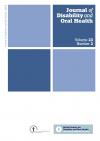Journal of Disability and Oral Health

- Cover Date:
- July 2022
- Vol:
- 23
- Issue:
- 2
Oral status and treatment need following radiotherapy for Head & Neck Cancer Part 2.
Oral status and treatment need following
radiotherapy for Head & Neck Cancer.
Part 2: Clinical findings at baseline and review three
years post radiotherapy
D MacCarthy,1 M Van Harten2 and O Omer3
1Associate Professor Consultant in Restorative Dentistry & Periodontology; 2 Biostatistician;
3 Associate Professor Consultant in Restorative Dentistry: Dublin Dental University Hospital, Faculty of Health Sciences, Trinity College Dublin, Dublin 2, Ireland.
Abstract
Objectives: To document the demographic characteristics and compare the dental status and treatment needs of
head and neck cancer patients at three years post-radiotherapy. Dental status and treatment needs of the patients
are presented in Part 2 of this report.
Material and Methods: Assessment of the dental status and treatment needs of 167 post-radiotherapy, head and
neck cancer patients included charting teeth present and carious, assessing oral hygiene and periodontal status
and measuring range of mandibular movement.
Results: Thirty-nine percent (39%) of patients smoked or had recently quit at baseline, versus 15% at review. At
baseline, 164 (98%) were dentate, 61% had 21+ teeth, 41% had coronal decay, 27% had root decay, 79% required
one or more dental extractions. A lowest CPITN score of 4 was recorded for 4% of individuals, dental plaque/gingival
bleeding scores of <30% were recorded for 17% and 62%, respectively. At review, 159 (95%) were dentate of whom
41.3% had 21+ teeth, 37% had coronal decay, 37% had root decay, 16% required one or more dental extractions. A
lowest CPITN score of 4 was recorded for 1% of individuals, dental plaque/gingival bleeding scores of <30% were
recorded for 57% and 81%, respectively. Maximum mandibular opening was <39mm in 23% of patients at baseline
and in 35% at review. Sixteen (9.6%) cases of osteoradionecrosis were recorded, 15 mandibular.
Conclusion: The patients in this study were dentate but their oral health was generally poor at baseline requiring
dental extractions, restorative and periodontal care. Ongoing dental supportive and preventative care is required
post-radiotherapy.
Key words: Head and Neck Cancer, pre- postradiotherapy, dental treatment need.
Introduction and
literature review
Radiation and surgery to the head and neck can have a
dramatic effect on the oral cavity and surrounding
structures. Side effects of radiation may be short term and
acute including mucositis, dry mouth and oral infection.
Long-term effects are caused by cellular and vascular changes
42 | Journal of Disability and Oral Health (2022) | 23/2
Date Manuscript Received:07/05/2021
Date Manuscript Accepted: 27/02/2022
Doi: 10.443/JDOH/MacCarthy_09
in soî‚ tissue and bone and include thinning of the tissues,
salivary gland hypofunction, loss of taste, reduced
remodeling capacity in bone, restricted mouth opening and
dysphagia (Epstein et al., 1999; Strojan et al., 2017; AarupKristensen et al., 2019; Baijens et al., 2021).
Management of oral disease pre-radiation should
“identify existing oral disease and risk, remove infectious
foci pre-radiotherapy, provide information regarding future
- Article Price
- £15.00
- Institution Article Price
- £
- Page Start
- 42
- Page End
- 50
- Authors
Articles from this issue
- Title
- Pg. Start
- Pg. End
- An evaluation of oral care under general anaesthesia in Special Care Dentistry within Ayrshire and Arran Public Dental Service
- 64
- 74
